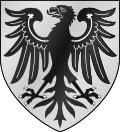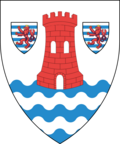Cantons of Luxembourg
 |
|---|
The 12 cantons (French: canton [kɑ̃tɔ̃] ⓘ; German: Kanton [kanˈtoːn] ⓘ; Luxembourgish: Kanton [ˈkɑnton])[a] of the Grand Duchy of Luxembourg are subdivisions at the first level of local administrative unit (LAU-1) in the European Union's Nomenclature of Territorial Units for Statistics for Eurostat purposes. They were subdivisions of the three districts of Luxembourg until 2015, when the district level of government was abolished. The cantons are in turn subdivided into 100 communes (i.e. municipalities).
Function
[edit]Unlike in Switzerland and similarly to France, Luxembourgish cantons have no administrative structure of their own—rather, they are used to delimitate electoral constituencies and judicial districts.[1] Until 2015, they also served to delimitate Luxembourg's three districts.
History
[edit]The origins of the cantons of Luxembourg lie in the decree of 31 August 1795 by the Committee of Public Safety during the French Revolutionary period.[2] This established 37 cantons in the Département des Forêts, grouped into 4 arrondissements (districts): Bitbourg, Diekirch, Luxembourg, and Neufchâteau.[2] The old feudal territorial divisions were replaced with a system of uniform administrative division into cantons of approximately equal size and population.[3]
The decree of 6 March 1802 reduced the number of cantons in the department to 28.[4]
This situation lasted until 1815, when the Congress of Vienna re-organised Europe's borders. The Duchy of Luxembourg lost its territories east of the Our, the Sauer and the Moselle rivers to Prussia.[2] The subsequent administrative reorganisation divided Luxembourg into 32 cantons, grouped into five arrondissements: Marche, Saint-Hubert, Neufchâteau, Diekirch, and Luxembourg.[2]
By royal decree of 2 January 1832, arrondissements were reduced in size, but their number increased from 5 to 8.[2] They were now named quarters, and later, districts.[2]
List
[edit]The following list gives the names of the cantons in French and Luxembourgish (in that order) which are both official languages of the Grand Duchy of Luxembourg:
| Name
Luxembourgish name |
Namesake commune | Electoral district | Coat of arms[5] | Area (km²)(2018)[6] |
Population (As of 2025[update])[7] |
Population Density Inhabitants/km2 (As of 2025[update])[8] |
Highest point | Lowest point |
|---|---|---|---|---|---|---|---|---|
| Clervaux
Klierf |
Clervaux | North | 
|
342.17 | 21,873 | 63.9 | 560 | 230 |
| Wiltz
Wolz |
Wiltz | North | 
|
264.55 | 19,944 | 75.4 | 537 | 233 |
| Vianden
Veianen |
Vianden | North | 
|
78.52 | 5,744 | 73.2 | 542 | 190 |
| Redange
Réiden |
Redange | North | 
|
267.49 | 21,442 | 80.2 | 554 | 232 |
| Diekirch
Dikrech |
Diekirch | North | 
|
204.51 | 36,240 | 177.2 | 525 | 175 |
| Mersch
Mersch |
Mersch | Centre | 
|
223.90 | 36,736 | 164.1 | 436 | 201 |
| Echternach
Iechternach |
Echternach | East | 
|
185.54 | 20,509 | 110.5 | 414 | 141 |
| Capellen
Capellen |
Mamer | South | 
|
199.21 | 55,513 | 278.7 | 398 | 242 |
| Luxembourg
Lëtzebuerg |
Luxembourg City | Centre | 
|
238.46 | 210,561 | 883 | 429 | 228 |
| Grevenmacher
Gréiwemaacher |
Grevenmacher | East | 
|
211.37 | 33,712 | 159.5 | 411 | 132 |
| Esch-sur-Alzette
Esch-Uelzecht |
Esch-sur-Alzette | South | 
|
242.77 | 195,091 | 803.6 | 435 | 224 |
| Remich
Réimech |
Remich | East | 
|
127.87 | 24,608 | 192.4 | 368 | 140 |
Maps
[edit]See also
[edit]- Category:Lists of cantons of Luxembourg
- ISO 3166-2:LU
- List of cantons of Luxembourg by area
- List of cantons of Luxembourg by highest point
- List of cantons of Luxembourg by lowest point
- List of cantons of Luxembourg by population
- List of cantons of Luxembourg by population density
Notes
[edit]- ^ Plural: French: cantons [kɑ̃tɔ̃] ⓘ; German: Kantone [kanˈtoːnə] ⓘ; Luxembourgish: Kantonen [ˈkɑntonən] or Kantoner [ˈkɑntonɐ].
References
[edit]- ^ "Le territoire du Luxembourg". luxembourg.public.lu (in French). 30 August 2021. Retrieved 2024-02-18.
- ^ a b c d e f Calmes, Albert (5 November 1952). "Origine du Canton d'Echternach". Luxemburger Wort (in French). p. 11. Retrieved 19 March 2024.
- ^ Calmes, Albert (20 May 1953). "Origine du canton de Diekirch". Luxemburger Wort (in French). p. 15. Retrieved 19 March 2024.
- ^ Calmes, Albert (7 June 1950). "Origine du Canton de Rédange". Luxemburger Wort (in French). p. 13.
- ^ "Kantone". Daniel Erpelding. 2010-01-20. Retrieved 2022-06-08.
- ^ "Population par commune au 1er janvier 2025". www.statistiques.public.lu. Statistics portal of the Grand-Duchy of Luxembourg. Retrieved 17 May 2025.
- ^ "Population by canton and municipality 2018" (PDF). www.statistiques.public.lu. Statistics portal of the Grand-Duchy of Luxembourg. Retrieved 11 May 2018.
- ^ "Densité de la population par canton et commune au 1er janvier (Habitants par km²)". www.statistiques.public.lu. Statistics portal of the Grand-Duchy of Luxembourg. Retrieved 17 May 2025.
External links
[edit] Media related to Cantons of Luxembourg at Wikimedia Commons
Media related to Cantons of Luxembourg at Wikimedia Commons



